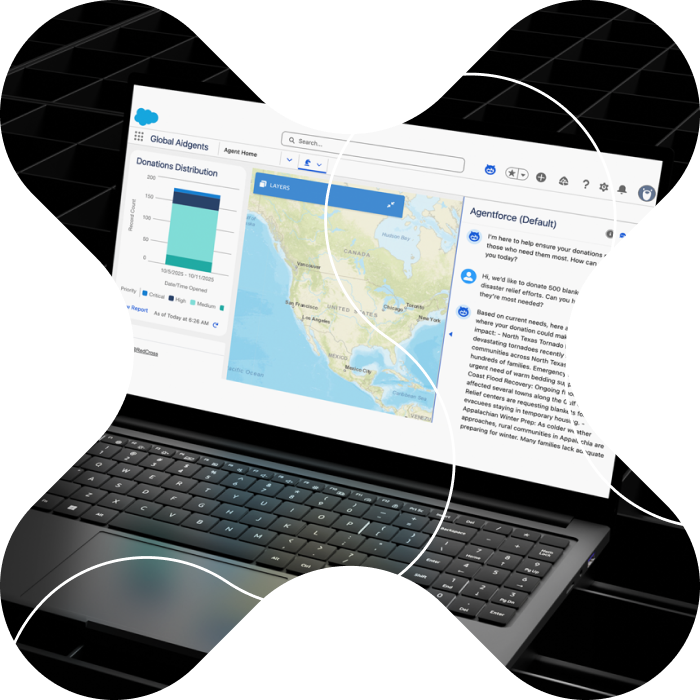What is agent-to-agent (A2A) communication?
In simple terms, agent-to-agent (A2A) communication is the communication system that allows autonomous AI agents to interact seamlessly. On the other hand, sources like Wallarm and Lisowski refer to A2A Protocol as a cross-platform specification for enabling AI agents to interact with each other and complete tasks.
In other words, we can describe A2A communication as a universal meeting room where every AI is invited and speaks the same structured language. Just like humans use languages (English, Italian, Spanish), AI agents communicate using A2A protocol as their common language to work together like a well-coordinated team.
A2A communication induces a significant shift in organizational operations by collaborating and delegating tasks across heterogeneous systems. Now, companies can enhance workflows, reduce manpower dependency, and improve decision-making capabilities.
How does A2A communication work? A few examples
Let’s imagine a company related to the distribution of printed and digital study material has a high demand for support and order tracking. Due to the massive volume of items sold and the seasonal load, managing customer inquiries fast is humanly impossible. As a customer-centric company, customer experience is a top priority, and it needs to be easy for clients to contact support.
Here's where AI agents and A2A communication turn up: they need to process different types of requests, understand the sentiment, and generate personalized responses. Internally, AI agents reroute the questions to domain-specific agents or involve humans in the loop. Different LLMs are used for specific tasks, like summarizing the content of long texts or documents and later locating references of order numbers. These AI agents not only provide quick responses, but they also enrich cases with information so that employees have more decision-driving data in complex scenarios.
Let’s see a few additional use cases:
- Imagine an online shopping portal. A customer's order placement on the portal triggers automatic communication between the portal’s software and that of managing inventory. The silent exchange under review ensures apt order processing and inventory revisions, demonstrating a prime example of A2A interaction.
- Another use case comes when we picture two applications—let’s call them App A and App B. App A possesses a specific feature that App B requires. The need to construct this feature anew in App B is circumvented through APIs; by utilizing the API from App A, App B can gain access to the desired feature, enabling the A2A interaction.
What’s the difference between A2A communication and human-to-machine communication?
A2A communication diverges from standard, human-to-machine exchanges. In the latter, a human user interacts with software to carry out a specific task, like document editing or internet browsing. Contrarily, agent-to-agent hinges on direct software-to-software conversations to execute tasks, with no human involvement required. The resulting workflow speeds up task completion, lowering the probability of human error in the process.
It’s clear that A2A communication has emerged as a cornerstone in present-day computing systems. It earned its spot through enabling various software platforms to interact in a seamless, integrated fashion, making significant contributions to a wide range of digital systems.
Here’s a summary.
Introducing Salesforce Agentforce
What is Salesforce Agentforce?
Salesforce Agentforce is a set of AI-powered productivity tools incorporated into the Salesforce ecosystem. This proactive, autonomous AI application provides specialized, always-on support to employees or customers through tailored agents. The platform enables AI agents to reply to customer inquiries or requests, execute complex tasks, integrate seamlessly with your marketing systems, and collaborate with other AI agents.
Learn more about Agentforce for marketers here.
What are the benefits of using Agentforce?
- Improve work processes: Using this tool can improve overall efficiency, as Agentforce can automate repetitive tasks, including administrative duties, and reduce reliance on manual labor.
- Lower operational costs: AI agents provide 24/7 support and can handle 90–99% of customer inquiries. Their replies come from reliable sources, like your company's knowledge or CRM data.
- Deliver quick and personalized responses: These agents can also personalize replies for each customer. This level of customization typically boosts satisfaction, increases engagement, and reduces churn.
- Identify and prioritize leads: Agentforce can also chat with your sales representatives, addressing their questions and objections, and offering hands-on tips. This type of work alone could boost sales by about 20% and increase ROI by nearly 30% in the retail industry.
- Create content: Agentforce agents can streamline every stage, from research and briefing to content writing. Their ability to adapt to your brand's voice and process large amounts of data allows them to draft high-quality copy, potentially leading to better marketing outcomes, brand consistency across channels, and higher engagement overall.
- Refine copies before going live: Agentforce can leverage customer data to drive engagement, suggest tailored solutions, and create content that resonates with your audience.
How Salesforce enables agent-to-agent communication
Agentforce is a top leader in streamlining operations with AI agents across organizations, whether it’s for marketing, sales, customer service, or beyond. Plus, it integrates seamlessly with applications within the Salesforce ecosystem. But enterprise platforms have become more complex, and more often than not they need to interact with third-party apps and external services like market analysis tools or payment systems.
From low code to pro code, Salesforce Platform provides the appropriate tools for each use case, whether simple or advanced. Flow Builder will become your best partner for orchestrating communications among agents and even talking to external systems. These invocations can move in both directions, either by enriching agents’ chat capabilities or by leveraging GenAI power from your existing flows.
A great way to make agents talk to each other and distribute the efforts is through flows. In one example, an agent is asked to provide information about the latest touchpoints with a customer. As this agent is not the specialist, it will invoke a flow to reroute the question to one or multiple dedicated agents. This way you can chain many steps and transform an inconvenient or dead-end task into a collaborative effort among autonomous agents.


References
“Agentforce: The AI Agent Platform.” Salesforce. Accessed June 4, 2025. https://www.salesforce.com/agentforce/.
google-a2a. “Google-A2A/A2A: An Open Protocol Enabling Communication and Interoperability between Opaque Agentic Applications.” GitHub. Accessed June 4, 2025. https://github.com/google-a2a/A2A.
Ilyin, Stepan. “What is A2A (Application-to-Application),” Wallarm, April 22, 2025, https://www.wallarm.com/what/what-is-a2a-application-to-application.
Kumar, Diwakar. “🤖 Unlocking the Power of Agent-to-Agent (A2A) Communication: Explained with Real-Life Analogies.” Medium, May 12, 2025. https://medium.com/@diwakarkumar_18755/unlocking-the-power-of-agent-to-agent-a2a-communication-explained-with-real-life-analogies-2bb5ecd2fa24.
Lisowski, Edwin. “What Every AI Engineer Should Know about A2A, MCP & ACP.” Medium, April 24, 2025. https://medium.com/@elisowski/what-every-ai-engineer-should-know-about-a2a-mcp-acp-8335a210a742.
Salesforce Support. “FR Best Practices for Building Agents in Agentforce | Agentforce .” YouTube, April 2, 2025. https://www.youtube.com/watch?v=7jmE6QzEnsY.
Thinqloud. “Bridging Worlds: How Salesforce Agentforce and Googles A2A Protocol Will Revolutionize AI Workflows.” LinkedIn, April 15, 2025. https://www.linkedin.com/pulse/bridging-worlds-how-salesforce-agentforce-googles-a2a-protocol-3ioic.
Trailblazing Together by @MCLearningCamp. “#2: How to Integrate MCE and Agentforce.” YouTube, April 15, 2025. https://www.youtube.com/watch?v=L9TJgJBjVJM.
Valoir. “Accelerating Time to Agentic AI Value: a Valoir Report “, June 2025. https://www.salesforce.com/en-us/wp-content/uploads/sites/4/documents/research/valoir-report-accelerating-agentic-ai-time-to-value.pdf.
Watkins, Charles. “Invoke Agentforce Agents with Apex and Flow”, April 3, 2025. https://developer.salesforce.com/blogs/2025/04/invoke-agentforce-agents-with-apex-and-flow.

.png)





